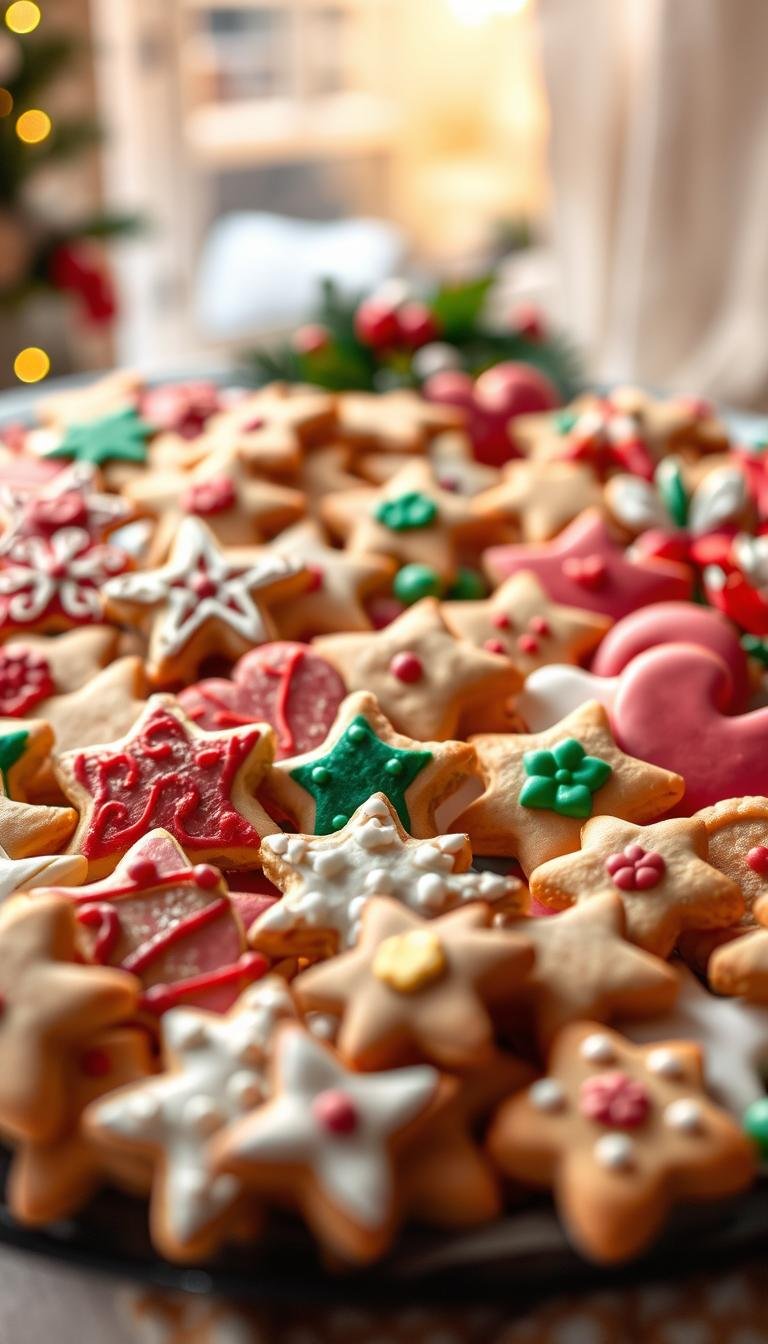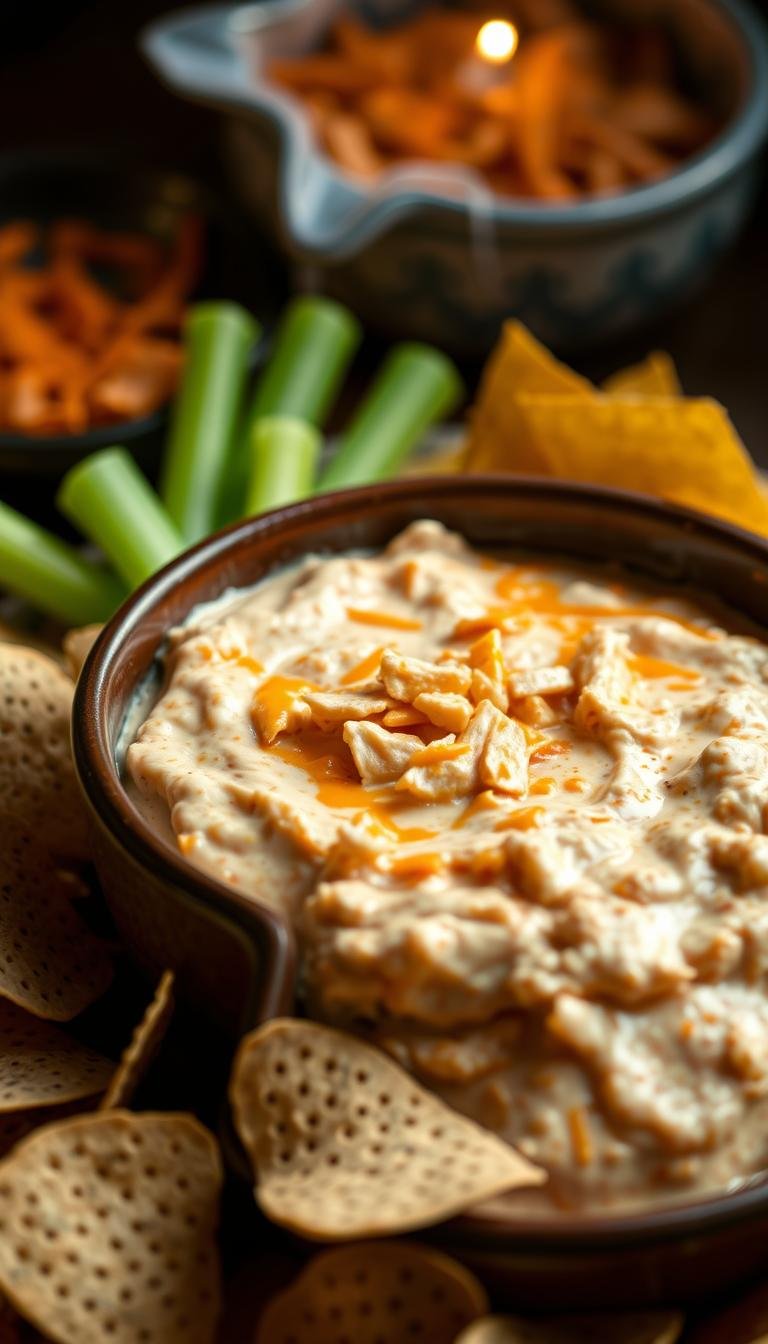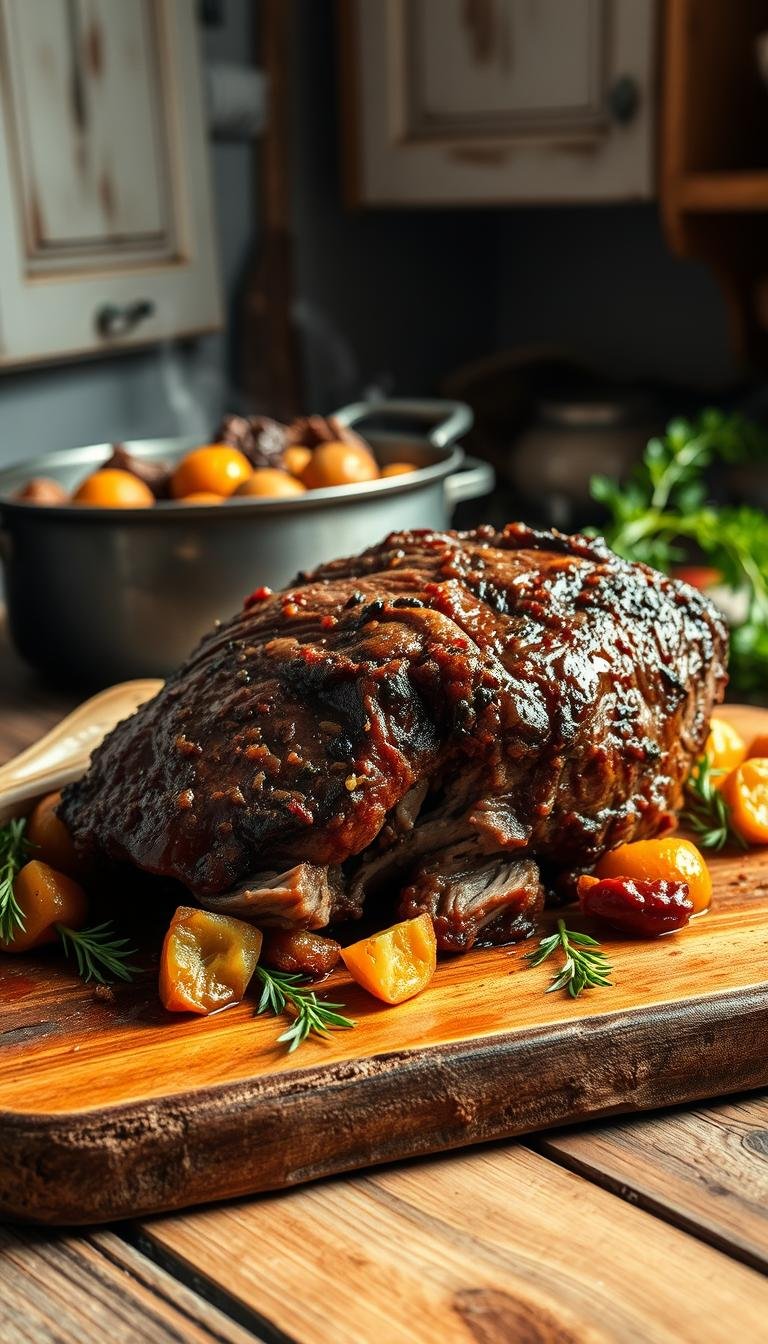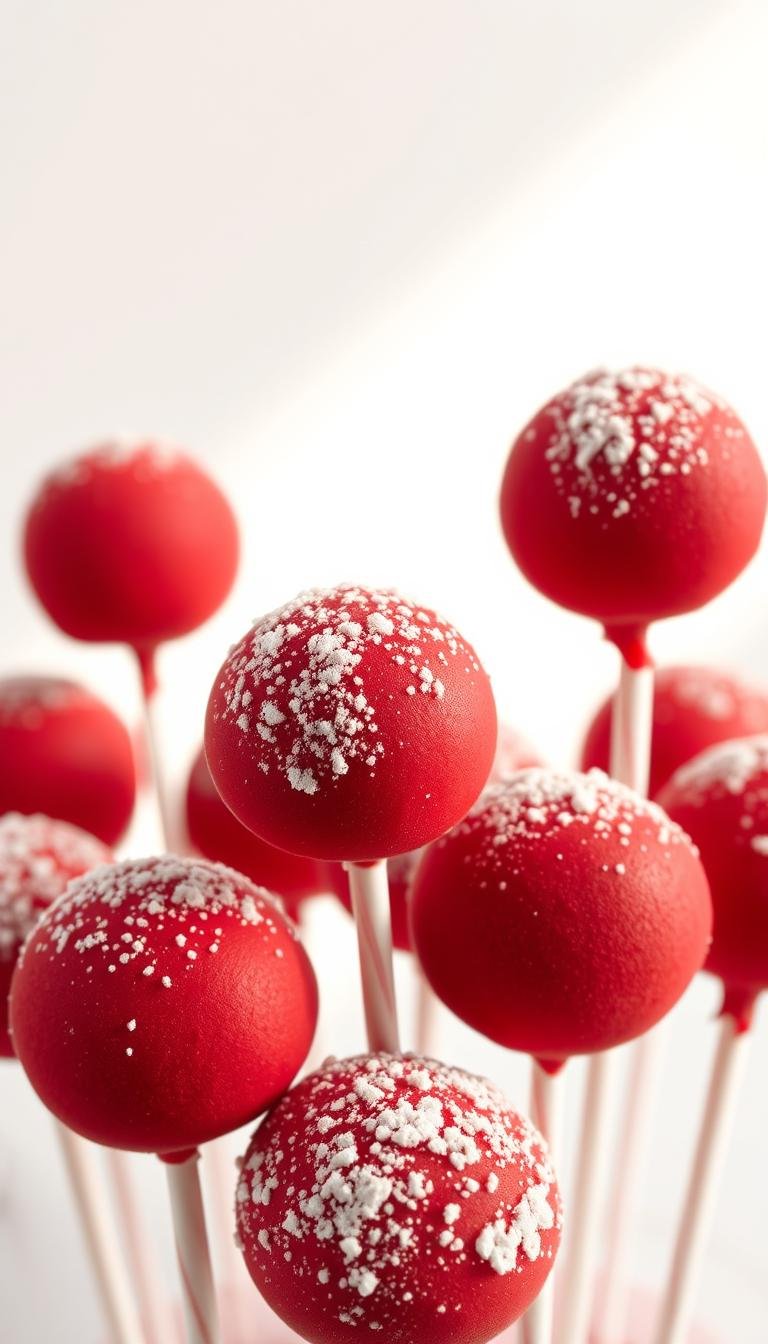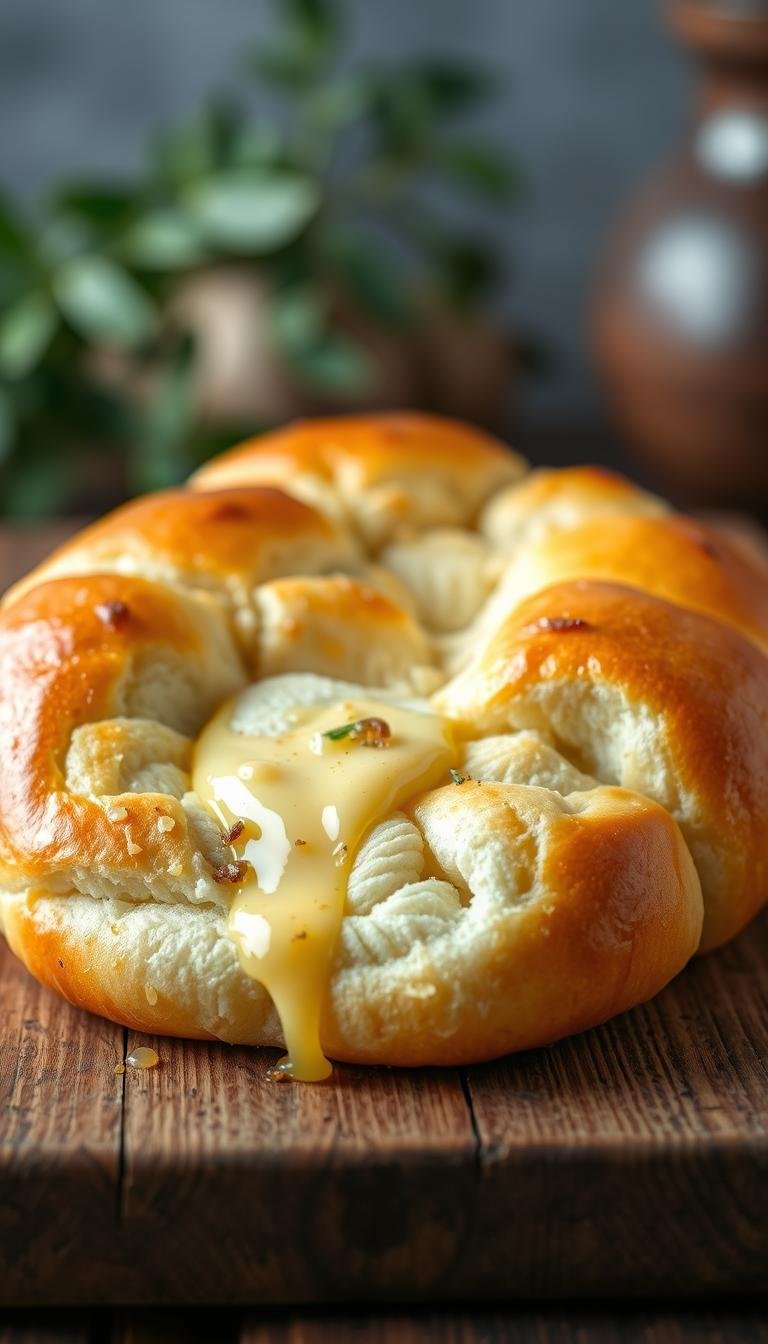25 Traditional German Christmas Cookies to Bake This Year
The tradition of baking German Christmas cookies goes back centuries. It fills homes with the smell of spices, nuts, and sweets during the holidays. In Germany, these cookies are a big part of Christmas, made with love and passed down through generations.
Traditional Christmas baking is getting more popular around the world. American home bakers want to make these European holiday treats in their kitchens. They explore holiday cookies to see the rich cultural heritage of Christmas in Germany.
Key Takeaways
- Discover 25 authentic German Christmas cookie recipes.
- Learn about the historical context and cultural significance of each cookie type.
- Gain practical baking tips for recreating these traditional treats.
- Explore a variety of cookie types, from spiced to nut-based and chocolate.
- Understand the importance of traditional Christmas baking in German culture.
The Magic of German Christmas Baking Traditions
Weihnachtsbäckerei is a special tradition in Germany. It mixes history, geography, and community. It started in medieval monasteries where monks baked sweet treats during Advent.
The History of Weihnachtsbäckerei (Christmas Baking)
The history of Weihnachtsbäckerei is rich. It began in the early Middle Ages. Only the wealthy could afford the spices and honey used in baking.
As trade routes grew, so did Christmas baking. Monasteries were key in this tradition. They used herbs and spices to make unique recipes.
Some key historical aspects include:
- The use of exotic spices like cinnamon, nutmeg, and cardamom, which were highly prized.
- The importance of honey as a sweetener before sugar became widely available.
- The role of monasteries in preserving and passing down baking techniques.
Why German Cookies Are Special During the Holidays
German Christmas cookies, or Weihnachtsplätzchen, are special. They have unique spice blends and are made with care. The spice mix Lebkuchengewürz is a big part of many German cookies.
Some reasons why German cookies stand out include:
- Unique Spice Combinations: The spice blends like Lebkuchengewürz make German cookies taste unique.
- Regional Variations: Each region in Germany has its own special cookies, showing local tastes and traditions.
- Cultural Significance: Baking and sharing cookies is a big part of German Christmas. It brings people together and connects them to the past.
25 Traditional German Christmas Cookies to Bake This Year
This holiday season, try 25 authentic Christmas cookie recipes from Germany. German Christmas cookies, or Weihnachtsplätzchen, are loved for their spices, nuts, and sweetness. They make homes warm and joyful.
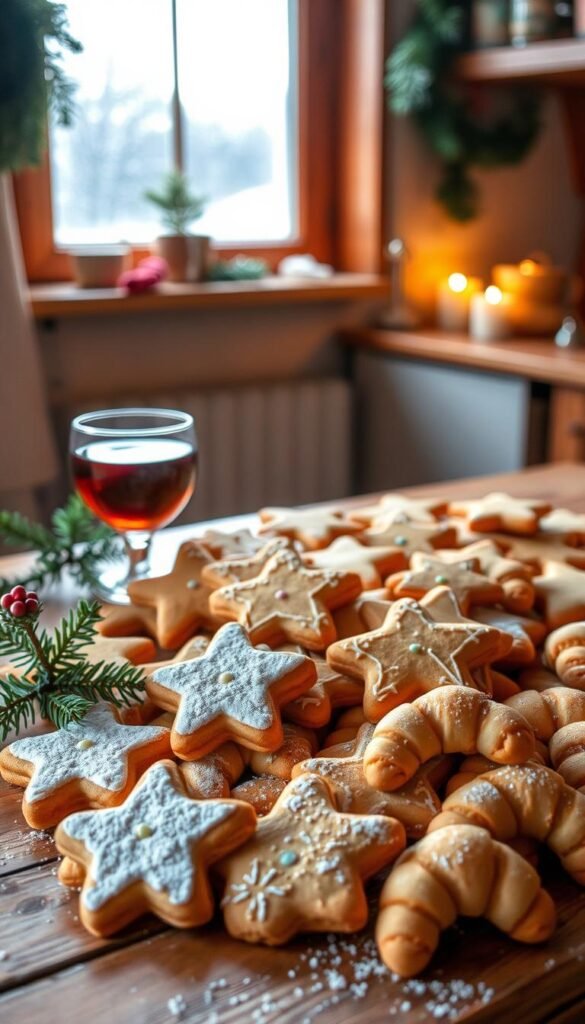
German Christmas cookies are special because they follow old recipes and baking ways. High-quality ingredients like fresh butter and whole spices are key. They make the cookies taste and feel just right.
What Makes These Recipes Authentic
Authentic German Christmas cookies use traditional ingredients and ways. Good butter makes them taste rich and soft. Whole spices add warmth, and nuts give a nice crunch.
Old German baking ways, like letting dough rest and controlling heat, are important. They help the cookies keep their shape and get the right feel.
“The art of German Christmas baking is not just about following a recipe, but about preserving a cultural heritage that brings families together during the holiday season.”
Regional Variations Across Germany
Germany’s different areas have their own Christmas cookie traditions. For example, Aachener Printen from North Rhine-Westphalia taste like spiced honey. Springerle from Baden-Württemberg are anise-flavored and have cool designs.
| Region | Cookie Type | Characteristics |
|---|---|---|
| North Rhine-Westphalia | Aachener Printen | Spiced honey cookies |
| Baden-Württemberg | Springerle | Anise-flavored, intricately molded |
| Bavaria | Lebkuchen | Gingerbread, often with nuts and spices |
These different cookies show Germany’s rich culture. They add variety to German Christmas baking.
Classic Spiced German Christmas Cookies
Baking spiced Christmas cookies is a beloved tradition in Germany. It’s filled with history and flavor. These cookies make homes smell warm and inviting.
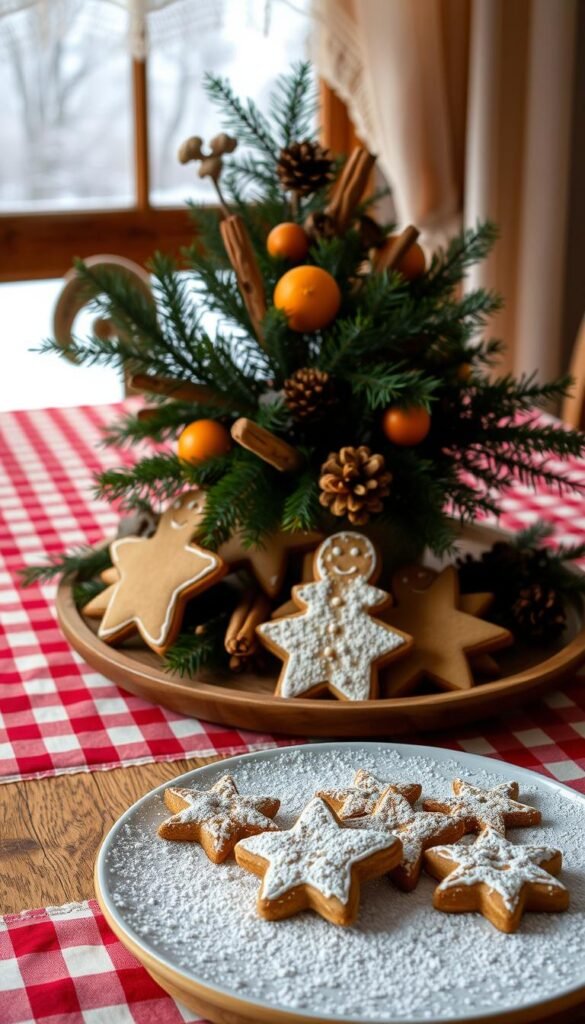
1. Lebkuchen: Germany’s Beloved Gingerbread
Lebkuchen is known as German gingerbread. It’s a Christmas favorite. You can find it soft and chewy or hard and crisp.
Recipe Basics and Variations
Lebkuchen has honey, spices like ginger and cinnamon, and nuts. Nürnberger Lebkuchen is soft and often glazed.
- Soft Lebkuchen: These are moist and sweet.
- Hard Lebkuchen: More like gingerbread, they can be decorated.
Cultural Significance
Lebkuchen dates back to the 13th century. It’s a Christmas symbol in Germany. Nürnberger Lebkuchen is special because of its protected status.
2. Pfeffernüsse: Spicy Pepper Nut Cookies
Pfeffernüsse means “pepper nuts.” They’re small, spiced cookies enjoyed at Christmas.
Recipe Basics and Variations
These cookies mix spices like pepper and cinnamon. They’re aged to get their flavor.
- Traditional Recipe: Ground spices and nuts are used.
- Variations: Some add molasses or different nuts.
Cultural Significance
Pfeffernüsse are a classic German Christmas cookie. They’re spicy and last long, perfect for sharing.
3. Zimtsterne: Star-Shaped Cinnamon Cookies
Zimtsterne, or cinnamon stars, are a favorite in Germany. They have a meringue topping and a star shape.
Recipe Basics and Variations
The dough is made with ground almonds, sugar, and cinnamon. It’s topped with meringue before baking.
- Classic Recipe: Cinnamon dough and meringue topping.
- Variations: Some adjust cinnamon or add spices.
Cultural Significance
Zimtsterne are tasty and symbolize Christmas. Their star shape reminds of the Star of Bethlehem.
4. Spekulatius: Intricately Molded Spice Cookies
Spekulatius are spiced cookies made with wooden molds. They have detailed designs.
Recipe Basics and Variations
The dough has spices like cinnamon and ginger. It’s pressed into molds before baking.
- Traditional Molds: Wooden molds create designs.
- Variations: Modern recipes use different spices or molds.
Cultural Significance
Spekulatius have a rich history, influenced by Dutch traditions. They’re loved in Germany for their spice and designs.
5. Aachener Printen: Historical Spiced Honey Cookies
Aachener Printen come from Aachen. They’re known for honey and spices.
Recipe Basics and Variations
They’re made with honey, spices, and sometimes nuts. Now, they use sugar beet syrup.
- Traditional Recipe: Honey and spices.
- Variations: Some use sugar beet syrup instead of honey.
Cultural Significance
Aachener Printen have a special status. They’re a big part of German Christmas traditions.
Traditional Nut-Based German Christmas Cookies
German Christmas traditions include many nut-based cookies. These cookies show the rich flavors of nuts. They also show regional preferences and baking history in Germany.

6. Vanillekipferl: Crescent-Shaped Vanilla-Almond Cookies
Vanillekipferl are a classic German Christmas cookie. They are crescent-shaped and have a delicate vanilla flavor. The dough includes ground almonds for a tender texture.
Recipe Basics and Variations
The traditional recipe for Vanillekipferl mixes ground almonds with flour, sugar, and vanilla. The dough is shaped into crescents and baked until golden. You can try different nuts or add citrus zest for a twist.
Cultural Significance
Vanillekipferl are loved in Germany, especially at family gatherings and holiday markets. Their delicate flavor and Advent season baking tradition make them special.
7. Haselnussmakronen: Hazelnut Macaroons
Haselnussmakronen are hazelnut-based macaroons. They are a staple in German Christmas baking. These cookies have a chewy center and a crisp exterior, baked on oblaten wafers.
Recipe Basics and Variations
For Haselnussmakronen, grind hazelnuts with sugar and egg whites. Then, bake until they have the right texture. You can add cocoa powder or use other nuts for a change.
Cultural Significance
Haselnussmakronen are loved for their hazelnut flavor and oblaten base. They prevent the cookies from spreading. They’re a hit at Christmas markets and family gatherings.
8. Nussstangen: Glazed Nut Bar Cookies
Nussstangen are glazed nut bar cookies. They look great and taste even better. These cookies mix nuts like almonds and hazelnuts with a sweet glaze.
Recipe Basics and Variations
Nussstangen dough combines ground nuts with flour and sugar. Then, a glaze made from powdered sugar and milk is added. You can try different nut mixtures or glazes.
Cultural Significance
Nussstangen are enjoyed for their sweet and nutty flavors. They’re a favorite at holiday gatherings and Christmas cookie exchanges.
9. Bethmännchen: Frankfurt’s Marzipan Delights
Bethmännchen are traditional marzipan cookies from Frankfurt. They’re known for their almond decorations. These cookies show Germany’s rich marzipan-making tradition.
Recipe Basics and Variations
Bethmännchen dough is made from ground almonds and sugar. Shape it into small balls and decorate with almonds. Traditional versions have three almonds.
Cultural Significance
Bethmännchen are named after the Bethmann family of Frankfurt. They symbolize the city’s baking heritage. They’re enjoyed during the Christmas season.
10. Mandelhörnchen: Chocolate-Dipped Almond Crescents
Mandelhörnchen are chocolate-dipped almond crescents. They mix chocolate’s richness with almonds’ delicate flavor. These cookies are a modern twist on traditional German baking.
Recipe Basics and Variations
Mandelhörnchen dough is made with ground almonds and sugar. Shape it into crescents and dip in chocolate. You can use different chocolates or add nuts to the coating.
Cultural Significance
Mandelhörnchen are loved for their crunchy almonds and smooth chocolate. They’re a popular treat during Christmas, showing the influence of international baking trends.
Chocolate and Cocoa German Christmas Cookies
German Christmas cookies now often include chocolate. This change has led to many tasty cookie types. They mix chocolate with German baking skills.
11. Dominosteine: Multi-Layered Chocolate Treats
Dominosteine have layers of gingerbread, fruit jelly, and marzipan. They are topped with chocolate. They started in the early 1900s and became popular after WWII.
Recipe Basics and Variations
To make Dominosteine, bake gingerbread and layer it with jelly and marzipan. Then, coat it with chocolate. You can try different jelly flavors and add nuts or spices to the gingerbread.
Cultural Significance
Dominosteine are important because they show a post-war change in German baking. They use what’s available to make a beloved treat. Now, they’re a key part of Christmas.
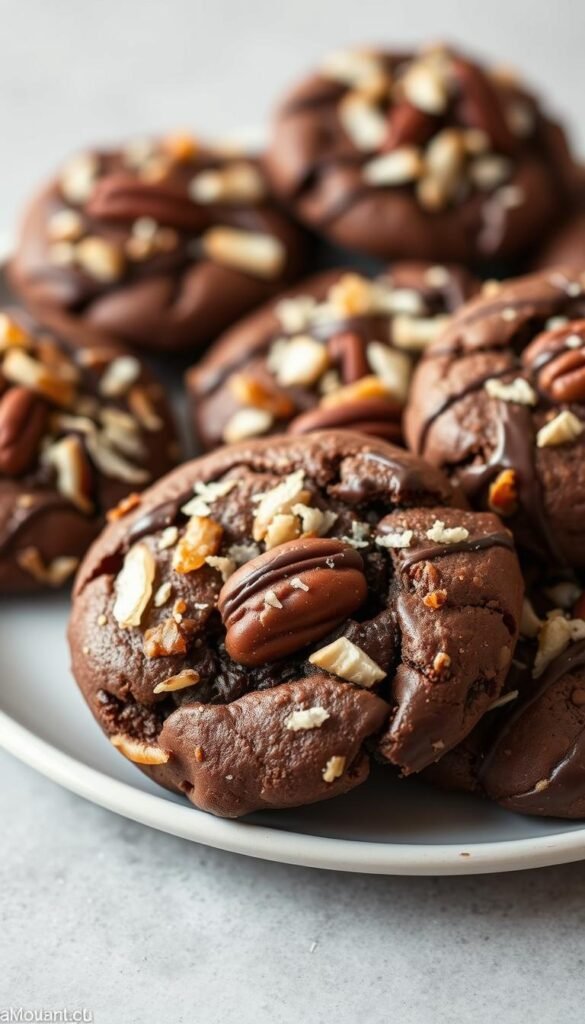
12. Kokosmakronen: Chocolate-Dipped Coconut Macaroons
Kokosmakronen are coconut macaroons dipped in chocolate. They offer a sweet and textured cookie. They’re a newer addition to German Christmas cookies.
Recipe Basics and Variations
To make Kokosmakronen, mix coconut with egg whites and sugar. Shape them and dip in melted chocolate. You can use different chocolates and add nuts or cocoa powder to the coconut mix.
Cultural Significance
Kokosmakronen show how German Christmas cookies have evolved. They use international ingredients like coconut in traditional baking.
13. Elisenlebkuchen: Premium Chocolate-Glazed Lebkuchen
Elisenlebkuchen are a special kind of lebkuchen. They have lots of nuts, little flour, and are glazed with chocolate. They’re a favorite among German Christmas cookies.
Recipe Basics and Variations
To make Elisenlebkuchen, mix ground nuts with honey, spices, and a little flour. Bake and glaze with chocolate. You can use different nuts and change the spice level.
Cultural Significance
Elisenlebkuchen are loved for their rich taste and texture. They show the high standard of traditional German baking.
14. Rumkugeln: Rum-Infused Chocolate Truffles
Rumkugeln are chocolate truffles with rum. They’re a treat for adults at Christmas. They’re easy to make and taste sophisticated.
Recipe Basics and Variations
To make Rumkugeln, mix chocolate with rum, cream, and butter. Shape into balls and coat with cocoa or nuts. You can use different liquors and change the rum amount.
Cultural Significance
Rumkugeln are special because they’re for adults. They’re a hit at Christmas gatherings.
15. Schokobrot: Chocolate Bread Cookies with Nuts
Schokobrot, or “chocolate bread,” is a cookie that feels like bread. It’s made with cocoa, nuts, and dried fruits. It’s a unique and tasty addition to German Christmas cookies.
Recipe Basics and Variations
To make Schokobrot, mix cocoa, nuts, dried fruits, and spices. Bake into a loaf. You can use different nuts and change the spice level.
Cultural Significance
Schokobrot is special for its new texture and flavor. It’s a modern twist on traditional German baking.
| Cookie Type | Main Ingredients | Cultural Significance |
|---|---|---|
| Dominosteine | Gingerbread, fruit jelly, marzipan, chocolate | Post-WWII innovation, staple Christmas treat |
| Kokosmakronen | Coconut, egg whites, sugar, chocolate | Modern addition, incorporating international ingredients |
| Elisenlebkuchen | Nuts, honey, spices, chocolate | Premium lebkuchen, high in nuts, minimal flour |
| Rumkugeln | Chocolate, rum, cream, butter | Adult-oriented, sophisticated flavor |
| Schokobrot | Cocoa, nuts, dried fruits, spices | Innovative texture, modern twist on traditional baking |
Jam and Fruit-Filled German Christmas Cookies
As Christmas gets closer, German bakers make many jam and fruit cookies. These treats are loved for their taste and cultural value. They show Germany’s rich baking history.
16. Spitzbuben: Jam-Filled Window Cookies
Spitzbuben, or “rascal” cookies, are a beloved German Christmas treat. They have “windows” cut out, showing a yummy jam inside. The jam is often red currant or raspberry.
Recipe Basics and Variations
To make Spitzbuben, you mix butter, sugar, and flour. Then, you roll it out and cut shapes. A smaller cutter makes the “windows.” The cookies are filled with jam before baking.
Cultural Significance
Spitzbuben are more than just cookies. They are a tradition of baking and sharing during Christmas. The name “Spitzbuben” means mischievous, adding fun to the holiday.
17. Heidesand: Traditional Shortbread Sand Cookies
Heidesand cookies have a special texture and taste. They are made by browning butter, creating a “heath sand” effect. These shortbread-like cookies are a key part of German Christmas baking.
Recipe Basics and Variations
The secret to Heidesand cookies is browning the butter. This gives them a nutty flavor. The dough is mixed with sugar and flour, then rolled out and cut into shapes before baking.
Cultural Significance
Heidesand cookies show Germany’s love for traditional baking. Browning butter is an art passed down through generations. It adds a unique flavor to these cookies.
18. Linzer Augen: Raspberry-Filled Sandwich Cookies
Linzer Augen, or “Linzer eyes,” are raspberry-filled sandwich cookies. They are named after Linz and show the Austrian influence on German baking.
Recipe Basics and Variations
Linzer Augen dough includes ground nuts for a rich texture. The cookies are filled with raspberry jam. The top cookie has an “eye” cut out.
Cultural Significance
Linzer Augen cookies show the cultural exchange between Austria and Germany in baking. Raspberry jam and ground nuts give these cookies a unique taste and texture.
19. Apfelplätzen: Spiced Apple Cookies
Apfelplätzen are spiced apple cookies that celebrate Germany’s apple harvest. They are flavored with cinnamon and other spices, capturing the essence of the season.
Recipe Basics and Variations
The dough for Apfelplätzen includes grated apples and spices like cinnamon and nutmeg. Sometimes, cardamom is added. The cookies are often topped with a crumbly oat mixture for extra texture.
Cultural Significance
Apfelplätzen cookies honor the apple harvest and Germany’s use of apples in baking. The spices used reflect the country’s love for warm, comforting flavors during Christmas.
20. Marzipanstollen: Mini Stollen Cookies with Marzipan
Marzipanstollen are small versions of the traditional German Christmas bread, Stollen. These cookies have marzipan and dried fruits, offering a compact version of the classic treat.
Recipe Basics and Variations
Marzipanstollen dough includes marzipan, dried fruits, and spices, like Stollen. The cookies are shaped like mini Stollen loaves and often topped with powdered sugar.
Cultural Significance
Marzipanstollen cookies make Stollen easier to share and enjoy during the holiday. They show German bakers’ creativity in adapting traditional recipes.
Unique German Christmas Cookie Specialties
German Christmas traditions are famous for their special cookies. These cookies show off old baking ways and the importance of Christmas in Germany.
21. Springerle: Anise-Flavored Relief Cookies
Springerle cookies are known for their designs and anise taste. They are made with special molds that create embossed cookies.
Recipe Basics and Variations
Springerle recipes use anise seeds for flavor. You can try different flavors or designs in the recipe.
Cultural Significance
Springerle cookies are very important in Southern Germany. The molds used are often passed down through families.
22. Butterplätzchen: Classic German Butter Cookies
Butterplätzchen, or butter cookies, are a beloved German Christmas treat. They are made with good butter and cut into shapes.
Recipe Basics and Variations
The basic recipe for Butterplätzchen includes butter, sugar, flour, and eggs. You can add different flavors or sugars to make it your own.
Cultural Significance
Butterplätzchen are a big part of German Christmas. Making and decorating these cookies is a family activity. Each region has its own special shapes and designs.
23. Berliner Brot: Chewy Chocolate-Nut Bars
Berliner Brot is a bar cookie with chocolate, nuts, and candied fruit. It has a chewy and dense texture.
Recipe Basics and Variations
Berliner Brot recipes use dark chocolate, hazelnuts, and candied fruit. You can try different nuts or spices to change it up.
Cultural Significance
Berliner Brot is a favorite Christmas cookie in Germany. Its rich flavor and chewy texture make it a holiday treat.
24. Anisplätzchen: Delicate Anise-Flavored Cookies
Anisplätzchen are delicate cookies with anise flavor. They are crisp and have a unique taste that’s part of German Christmas baking.
Recipe Basics and Variations
Anisplätzchen recipes use anise seeds or extract. You can try different sugars or spices to add to the anise flavor.
Cultural Significance
Anisplätzchen are a big part of German Christmas. The anise flavor is a classic in many German Christmas cookies.
25. Schwarz-Weiß-Gebäck: Elegant Black and White Cookies
Schwarz-Weiß-Gebäck, or black and white cookies, are striking. They mix vanilla and chocolate doughs in a marbled or checkerboard pattern.
Recipe Basics and Variations
To make Schwarz-Weiß-Gebäck, you mix vanilla and chocolate doughs. You can try different flavors or patterns in the recipe.
Cultural Significance
Schwarz-Weiß-Gebäck shows off the baker’s skill. Making these cookies is a way to show off baking talent and attention to detail.
Essential Tips for Authentic German Christmas Cookie Baking
German Christmas cookie baking is an art. It needs special ingredients, techniques, and tools. To get the real taste and feel, knowing the key elements is important.
Key Ingredients That Make the Difference
Choosing the right ingredients is key for real German Christmas cookies. European-style butter is best for its rich taste and soft feel. Nuts like hazelnuts and almonds add special flavors and textures.
Spices like true cinnamon, cardamom, and star anise bring warmth and depth. They make the cookies unique.
| Ingredient | Description | Tip |
|---|---|---|
| European-style butter | Higher butterfat content | Use for richer flavor |
| Hazelnuts and almonds | Nut varieties | Toast for enhanced flavor |
| True cinnamon, cardamom, and star anise | Specialized spices | Use freshly ground for best flavor |
Traditional Techniques and Special Tools
German cookie baking uses special techniques and tools. Dough resting times help flavors grow and dough relax. This makes it easier to shape.
Precise temperature control is also key. It affects the cookies’ texture and how they feel.
Tools like wooden Springerle molds and adjustable rolling pins help get traditional shapes and even thickness. The right storage keeps cookies fresh and flavorful.
- Wooden Springerle molds for traditional designs
- Adjustable rolling pins for consistent thickness
- Specialized cookie cutters for unique shapes
- Traditional storage containers for preserving freshness
Storing and Presenting Your German Christmas Cookies
Storing and presenting German Christmas cookies is a special tradition. It keeps the cookies fresh and can even make them taste better over time.
Proper Storage Methods for Maximum Freshness
To keep your German Christmas cookies fresh, it’s key to understand “reifen lassen”. This means letting cookies mature. Types like Lebkuchen and Pfeffernüsse taste best when they rest.
Use Plätzchendosen, or metal tins, for storing. They seal well and have separate spots for each cookie type.
When layering cookies, use parchment paper to stop them from sticking. Keep strong flavors away from delicate ones. This keeps each cookie’s taste unique.
Some cookies need air, while others should be sealed tight. For example, Marzipanstollen needs a sealed container to stay fresh.
Creating a Traditional German Cookie Gift Box
The Bunter Teller, or colorful plate, is a big part of German Christmas. A good cookie mix has different textures, tastes, and looks.
When arranging cookies, group similar ones together. Balance colors and shapes for a pretty display.
Use decorative tins, cellophane bags, or wax paper to package cookies. Homemade German Christmas cookies show love and care. As they say, “
Sharing cookies is sharing love.
“
By storing and presenting your German Christmas cookies right, you keep them fresh. You also honor the traditions that make them special.
Conclusion
Baking German Christmas cookies is special. It connects us to centuries of tradition. These cookies add a unique taste to the holiday season.
By baking these cookies, families make lasting memories. Starting simple and then trying harder recipes helps bakers grow. It shows the beauty of German Christmas baking.
Preserving baking heritage is about sharing joy. German Christmas cookies offer a special taste and look. They are a nice change from usual American cookies.
Trying these German Christmas cookies is a full holiday experience. It’s not just about the taste. It’s about connecting with tradition and making new memories.
